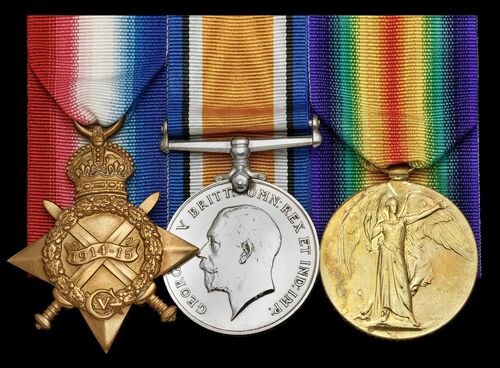
Auction: 23113 - Orders, Decorations and Medals - e-Auction
Lot: 378
'Darkness succeeded light and groping my way forward I passed a number of dead men and came across a boy (Mellish), a splendid little chap, one arm and a leg was off. He was bleeding to death, quite conscious and most plucky, I had him taken below as well as many others. Mellish died one hour afterwards.
On reaching the bridge I met the Commander who sent me to report on casualties, I went down aft stopping to see some dead put over the side and then down the hatch to the central passageway which was in places running with blood. The doctors were operating in the Stokers' bathroom; they were doing an amputation when I arrived. Not a murmur rose, not a sound, not a groan came from these wrecks of humanity lying on the deck, the tables and the sideboard. A whispered request for a cigarette was all I heard …'
Lieutenant Stephen King-Hall, R.N., recalls horrific scenes aboard H.M.S. Southampton following her point-blank encounter at Jutland; see Jutland 1916 - Death in Grey Waters, by Nigel Steel and Peter Hart.
The campaign group of three awarded to Able Seaman H. H. Hayward, Royal Naval Volunteer Reserve, who was killed in action at the Battle of Jutland on 31 May 1916 whilst serving on Southampton
Southampton's gallant duel with five enemy ships - including the Frauenlob which she torpedoed - resulted in her deck personnel suffering 75% casualties
In the words of her Captain, 'the range was amazingly close - no two groups of such ships have ever fought so close in the history of this war. There could be no missing …'
1914-15 Star (ZP-1121, H. H. Hayward. A.B., R.N.V.R.); British War and Victory Medals (Z.P.1121 H. H. Hayward. A.B. R.N.V.R.), extremely fine (3)
Herbert Henry Hayward was born on 8 January 1897 and was a tailor's assistant living at 7 Nevis Road, Balham, London when he joined the Royal Naval Volunteer Reserve on 12 June 1915. Having served with the 1st Battalion, Royal Naval Division, he was attached to Palace and then drafted for duty with the Grand Fleet on 14 September 1915.
He was aboard the Southampton at the Battle of Jutland. She was a cruiser of 5,400-ton displacement, built in 1912 and armed with eight 6-inch guns. She served at the Battles of Heligoland Bight and Dogger Bank and pursued the German Squadron after their attack on Scarborough. At Jutland, she played a crucial scouting role as part of Admiral Beatty's battlecruiser fleet. Southampton was the first ship to sight the German High Seas Fleet and her baptism of fire at Jutland is vividly described by Lieutenant Stephen King-Hall, R.N.:
'We crouched down behind the tenth-of-an-inch plating and ate bully beef but it didn't seem to go down very easily. It seemed rather a waste of time to eat beef, for surely in the next ten minutes one of those 11-inch shells would get us, they couldn't go on falling just short and just over indefinitely, and, well, if one did hit us - light cruisers were not designed to digest 11-inch high explosives in their stomachs.
The Sub, who was practically speechless owing to his bad throat, and I agreed that we would not look at the Hun line. But we could never resist having a peep about once a minute and, somehow, we always seemed to look just as two or three of the great brutes flickered flames from their guns at us, and we knew that another salvo was on its way across.
We knew the time of flight was twenty-three seconds, and the Sub had a wrist-watch with a prominent second hand - we almost agreed to throw it overboard after three-quarter of an hour's shelling; at the twenty-third second the Sub would make a grimace, and, as if in reply, a series of splitting reports and lugubrious moans announced that the salvo had arrived. Frequently they were so close that torrents of spray from the splashes splattered down on the boat deck.
We all compared notes afterwards and decided during this hour about fifty to sixty shells fell within 100 yards of the ship, and many more slightly farther off.'
Amazingly, Southampton escaped serious damage but at 2220 hours five unidentified ships appeared on her starboard beam. What followed was a terrifying three-and-a-half-minute point-blank firefight of the hair-raising kind, King-Hall concluding, 'the range was amazingly close - no two groups of such ships have ever fought so close in the history of this war. There could be no missing.'
At a cost of 75% casualties to her upper deck personnel - her losses amounted to 29 killed and 60 wounded - Southampton torpedoed the enemy cruiser Frauenlob.
Hayward was killed in action and is commemorated upon the Portsmouth Naval Memorial.
Subject to 20% VAT on Buyer’s Premium. For more information please view Terms and Conditions for Buyers.
Sold for
£700
Starting price
£140




